Meeting the next generation of scientists: the European Union Contest for Young Scientists Inspire article
As young scientists from across Europe gathered in Bratislava to exhibit their projects, find out what impressed the jury most.
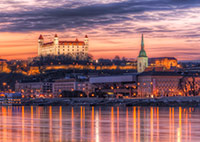
the Slovak capital Bratislava.
Image courtesy of Miroslav
Petrasko / Flickr
The 2012 European Union Contest for Young Scientists (EUCYS)w1 took place in the beautiful Slovak capital of Bratislava. For three days, 117 contestants aged 16-21 from 37 countries gathered in the Incheba exposition centre, all eager to present their work. As a new jury member, I was overwhelmed by the quality of the science displayed.
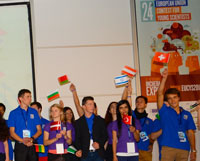
came from 37 countries.
Image courtesy of the
European Commission
Picking just a few winners from 83 amazing projects in disciplines as varied as engineering, biology, social science and mathematics, all of which had already won first prize in their national contests, was an extremely difficult task.
The three cash prizes offered by the European Commission were awarded to 19-year-old Austrians Philip Huprich, Manuel Scheipner and Daniel Zindl for developing an engineering solution to protect cameras in extreme environments; Mark James Kelly (18) and Eric Doyle (19) from Ireland for mathematically simulating how objects respond to gravity in particular environments; and Jakub Nagrodzki (17) from Poland for synthesising a modified molecule that can allow drugs to enter the nucleus of a cell, which offers the potential to treat various genetic diseases.
In addition, there were 19 special prizes, among them visits to research sites, including the eight members of EIROforumw2, the publisher of Science in School. Céline Lay, Fanny Risbourg and Ophélia Bolmin, three 18-year-old French engineers who designed an energy-efficient hexapedal robot, will visit the world’s largest particle physics laboratory, CERNw3, in Geneva, Switzerland. EFDA-JETw4, the European fusion energy experiment in Culham, UK, will welcome Tim Piper (16) from Germany, a young microscope enthusiast who has found ways of improving light microscopy images.
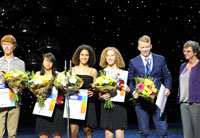
right) awarded the
EIROforum prizes at EUCYS
2012.
Image courtesy of the
European Commission
Sweden’s Nils Wilhelm Ygge’s (19) project, to fly a balloon to an altitude of 30 000 m to take photographs, will enable him to attend one of the European Space Agency (ESA)’sw5 major five-day space science conferences in Europe. The main site of the European Molecular Biology Laboratory (EMBL)w6 in Heidelberg, Germany, will open its doors to Tim Prezelj (18), a biologist from Slovenia who produced a chimeric receptor which could potentially be used to design a vaccine against malignant melanoma.
Thomas Glenn Myers (18) from the UK was awarded a visit to the European Southern Observatory (ESO)’sw7 telescopes in Chile. In his search for gravitational lensing systems, this dedicated physicist scanned 10 000 images of galaxies by eye. The European X-ray free-electron laser facility (European XFEL)w8 in Hamburg, Germany, will welcome the Israeli contestant Alfarook Abu Alhassan (18), who studied the kinetics of water crystallisation in porous media.
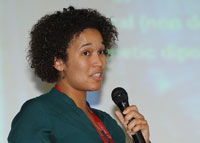
one of the EIROforum
lectures at EUCYS in
Bratislava.
Image courtesy of the
European Commission
At the Institut Laue-Langevin (ILL)w9 in Grenoble, France, where we host the world’s most intense neutron source, we are lucky to host 19-year-old Austrians Lucas Noel Sulzberger and Robert Gautsch, who developed a faster way of detecting Clostridium spores in dairy products. Helen Mary Sheehan (18) from the UK will visit the European Synchrotron Radiation Facility (ESRF)w10, after she impressed the jury by processing and characterising a new steel alloy using selective laser melting.
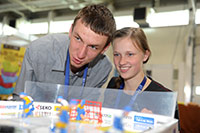
lectures, contestants got to
relax and play.
Image courtesy of the
European Commission
To broaden the participants’ horizons, daily lectures offered an insight into different areas of science. Jeremy Philpott from the European Patent Office gave a talk to raise patent awareness, and three lectures were given by members of EIROforum. Carillo Montoya from CERN spoke about the Higgs boson, Jean Pierre Guignard from ESA introduced students to Earth observation from space, and I represented ILL with a lecture about the impact of neutrons in the life sciences.
The EUCYS contestants are among Europe’s brightest young scientists but they are also young people like any other. In between jury visits and lectures, they had the opportunity to relax, playing table football or board games, and the varied social and cultural programme encouraged them not only to swap their ideas about science but also to make new friends.
I felt very privileged to meet the next generation of scientists. Their enthusiasm for their projects and curiosity about science was extremely refreshing. This was undoubtedly one of the highlights of my year.
Web References
- w1 – Find out all about EUCYS 2012, including all projects and winners.
- w2 – EIROforum is a collaboration between eight of Europe’s largest inter-governmental scientific research organisations, which combine their resources, facilities and expertise to support European science in reaching its full potential. As part of its education and outreach activities, EIROforum publishes Science in School.
- w3 – Based in Geneva, Switzerland, CERN is the world’s largest particle physics laboratory
- w4 – Situated in Culham, UK, JET is Europe’s largest fusion device. Scientific exploitation of JET is undertaken through the European Fusion Development Agreement (EFDA).
- w5 – ESA is Europe’s gateway to space, with its headquarters in Paris, France.
- w6 – EMBL is Europe’s leading laboratory for basic research in molecular biology, with its headquarters in Heidelberg, Germany.
- w7 – ESO is by far the world’s most productive ground-based astronomical observatory, with its headquarters in Garching near Munich, Germany, and its telescopes in Chile.
- w8 – European XFEL is a research facility currently under construction in the Hamburg area, Germany. It will generate extremely intense X-ray flashes for use by researchers from all over the world.
- w9 – ILL is an international research centre at the leading edge of neutron science and technology, based in Grenoble, France.
- w10 – Situated in Grenoble, France, ESRF operates the most powerful synchrotron radiation source in Europe.
- w11 – The EUCYS website lists the national organisers of contests for young scientists, the winners of which take part in EUCYS.
Institutions






